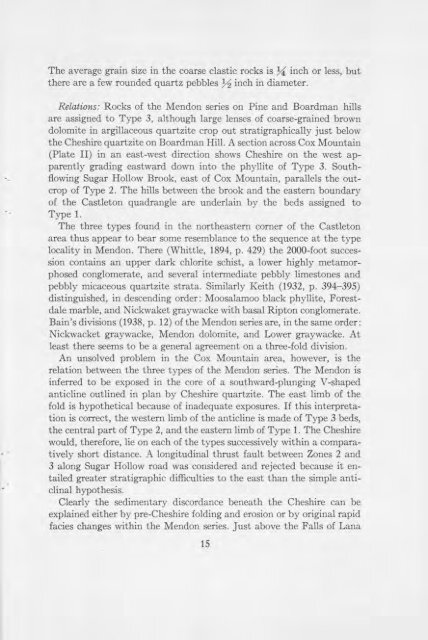STRATIGRAPHY AND STRUCTURE CASTLETON AREA VERMONT
STRATIGRAPHY AND STRUCTURE CASTLETON AREA VERMONT
STRATIGRAPHY AND STRUCTURE CASTLETON AREA VERMONT
Create successful ePaper yourself
Turn your PDF publications into a flip-book with our unique Google optimized e-Paper software.
The average grain size in the coarse clastic rocks is Y4 inch or less, but<br />
there are a few rounded quartz pebbles 3/ inch in diameter.<br />
Relations: Rocks of the Mendon series on Pine and Boardman hills<br />
are assigned to Type 3, although large lenses of coarse-grained brown<br />
dolomite in argillaceous quartzite crop out stratigraphically just below<br />
the Cheshire quartzite on Boardman Hill. A section across Cox Mountain<br />
(Plate II) in an east-west direction shows Cheshire on the west apparently<br />
grading eastward down into the phyllite of Type 3. Southflowing<br />
Sugar Hollow Brook, east of Cox Mountain, parallels the outcrop<br />
of Type 2. The hills between the brook and the eastern boundary<br />
of the Castleton quadrangle are underlain by the beds assigned to<br />
Type 1.<br />
The three types found in the northeastern corner of the Castleton<br />
area thus appear to bear some resemblance to the sequence at the type<br />
locality in Mendon. There (Whittle, 1894, p. 429) the 2000-foot succession<br />
contains an upper dark chlorite schist, a lower highly metamorphosed<br />
conglomerate, and several intermediate pebbly limestones and<br />
pebbly micaceous quartzite strata. Similarly Keith (1932, p. 394-395)<br />
distinguished, in descending order: Moosalamoo black phyllite, Forestdale<br />
marble, and Nickwaket graywacke with basal Ripton conglomerate.<br />
Bain's divisions (1938, p. 12) of the Mendon series are, in the same order:<br />
Nickwacket graywacke, Mendon dolomite, and Lower graywacke. At<br />
least there seems to be a general agreement on a three-fold division.<br />
An unsolved problem in the Cox Mountain area, however, is the<br />
relation between the three types of the Mendon series. The Mendon is<br />
inferred to be exposed in the core of a southward-plunging V-shaped<br />
anticline outlined in plan by Cheshire quartzite. The east limb of the<br />
fold is hypothetical because of inadequate exposures. If this interpretation<br />
is correct, the western limb of the anticline is made of Type 3 beds,<br />
the central part of Type 2, and the eastern limb of Type 1. The Cheshire<br />
would, therefore, lie on each of the types successively within a comparatively<br />
short distance. A longitudinal thrust fault between Zones 2 and<br />
3 along Sugar Hollow road was considered and rejected because it entailed<br />
greater stratigraphic difficulties to the east than the simple anticlinal<br />
hypothesis.<br />
Clearly the sedimentary discordance beneath the Cheshire can be<br />
explained either by pre-Cheshire folding and erosion or by original rapid<br />
facies changes within the Mendon series. Just above the Falls of Lana<br />
15













